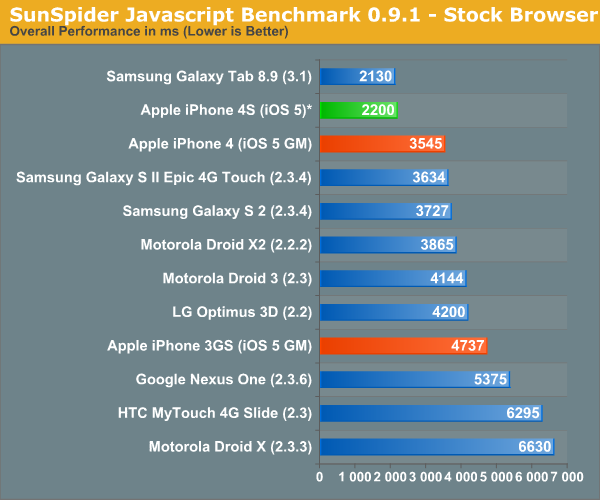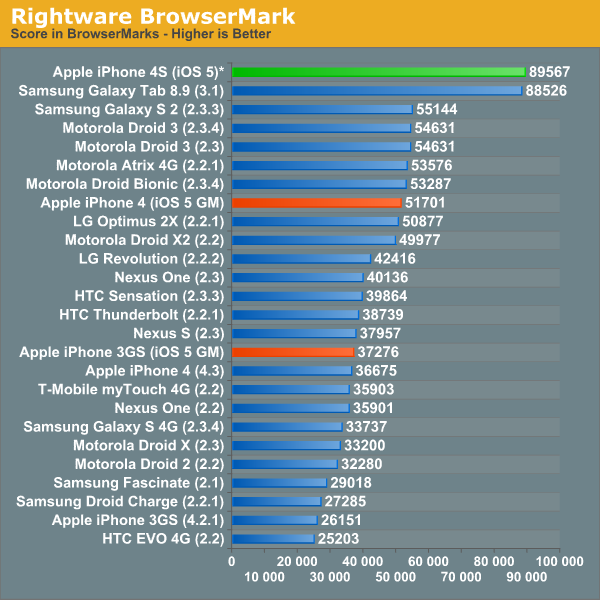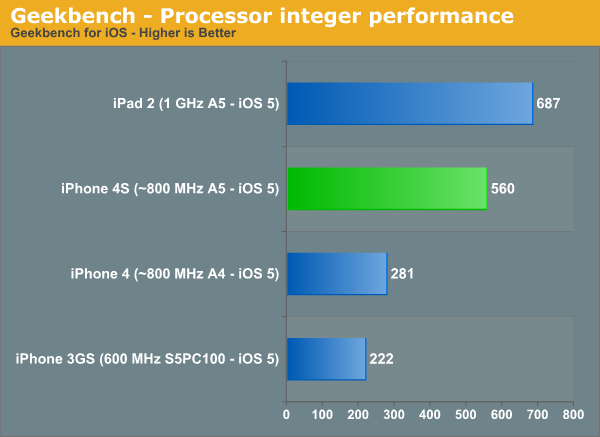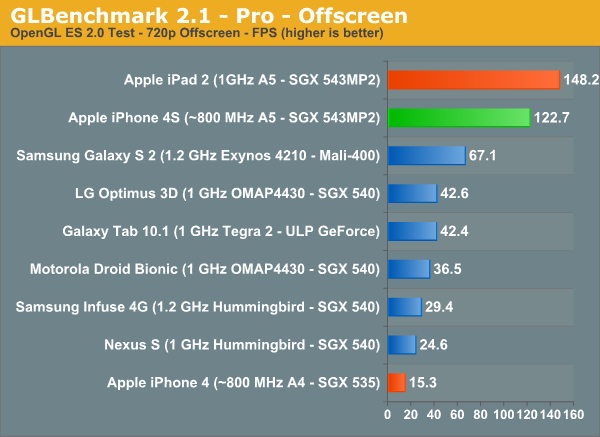iPhone 4S Preliminary Benchmarks: ~800MHz A5, Slightly Slower GPU than iPad 2, Still Very Fast
by Anand Lal Shimpi & Brian Klug on October 11, 2011 3:22 AM EST- Posted in
- Smartphones
- Apple
- Mobile
- iPhone 4S
- SoCs
Apple's ability to control the entire information chain, down to the point of limiting leaks, appears to be gradually slipping as it grows as a company. Case in point are the numerous hardware and performance leaks surrounding the newly launched iPhone 4S. Little did we know that several weeks ago we were staring at photos of the 4S' PCB, and more recently we've seen the first performance results from Apple's first A5 based smartphone thanks to a few eager users around the web. We've compiled these results here from various sources (all linked below) and compared them to our existing database of tests.
The results are pretty much as expected. Javascript performance finally catches up to Tegra 2 based Honeycomb devices, while general CPU performance is significantly higher than the iPhone 4. I suspect Ice Cream Sandwich will bridge the Android smartphone gap (the Honeycomb equipped Gtab 8.9 is here to give you an idea of where a more modern Android browser ends up).
Keep in mind that all of these tests measure performance of the software stack in addition to the hardware. In particular the web browser tests depend largely on browser optimizations, which is why we see differences between similar hardware running different browser versions. Also note that all results were run at stock, with the stock browser. Finally, although these browser tests were captured on video we'll still be running our official tests once our 4Ses arrive and will update accordingly.


Using some of the integer and fp tests of published Geekbench scores we can already conclude that Apple is shipping a lower clocked A5 in the iPhone 4S than it does in the iPad 2. This naturally makes sense as the iPhone 4S has a much smaller 5.25 Whr battery. Based on the Geekbench results it looks like the iPad 2 is clocked around 25% higher than the iPhone 4S, pegging the latter's clock speed at 800MHz.


A lower clock not only means higher yields from the factory, but likely a lower operating voltage as well. Dropping a CPU's core voltage, yields a greater-than-linear decrease in power consumption, making the marginal loss in clock speed a good choice. At a lower operating frequency than its Android competitors, Apple does have to exploit its strengths in software to avoid any tangible performance penalties. Apple has traditionally done this very well in the past, so I don't expect the loss of frequency to be a huge deal to the few who do cross-shop iOS and Android.
Unsurprisingly, memory bandwidth doesn't appear to have gone up either compared to the iPad 2's A5 (taking into account scaling due to CPU clock increases). The Samsung part number on the iPad 2's A5 indicates two LPDDR2-800 die on package, it's safe to assume that whatever Apple clocked the memory interface at in the iPad 2 remains unchanged in the iPhone 4S.
The GPU results tell a similar story courtesy of some early GLBenchmark 2.1 results. The 960 x 640 results are useless as they are bound by vsync at ~60 fps. Luckly GLBenchmark 2.1 added an off-screen render mode at 1280 x 720 where we can really see the differences between the iPad 2 and iPhone 4S A5 implementations:


Here the iPad 2 holds a ~21% performance advantage, which once again I assume to be all related to clock speed. Also note the huge advantage over the existing iPhone 4. The GPU power in the 4S should be more than enough to run any well written, current generation title at well north of 30 fps on its display.
We'll be reviewing the iPhone 4S in the coming weeks, stay tuned!
Source: GLBenchmark Database, Geekbench Database, Macrumors










216 Comments
View All Comments
steven75 - Tuesday, October 11, 2011 - link
Using stock browser and ROM? This is supposed to be a comparison test after all.Tomne - Tuesday, October 11, 2011 - link
Iphone 4 here : 4505 (0.9)Samsung Galaxy S : 3182 (0.9)
Beating the SGSII seems a little too much. How about some real numbers Anandtech ?
doobydoo - Sunday, October 16, 2011 - link
Why would it seem too much?The iPhone 4S is faster.
enterco - Tuesday, October 11, 2011 - link
Anand, I see you associate the SunSpider Javascript Benchmark with the device. I'm not so sure that the browser used should be omitted.I've made a test on my device, and I found that a third-party web browser (Opera Mobile) is the fastest browser according to this benchmark, two times faster than the browser included in my Android device. I didn't made any tests with Firefox (mobile version), it's too slow for me.
hlovatt - Tuesday, October 11, 2011 - link
It seems like you are really trying very hard to make Android look good! You said you expect the next version of Android "to narrow the gap" and in a couple of charts show a Galaxy tablet in comparison to phones and don't show an iPad for comparison in these.Why not just say: "It is the fastest phone money can buy - bar none."
Personally I prefer your reviews when you states the facts and let the numbers do the talking rather than attempt to provide "false" balance where the journalist feels it necessary to say something nice about everything.
FATCamaro - Tuesday, October 11, 2011 - link
This. There is no reason to bring tablets into this. When you show the Galaxy 8.9 you don't show the ipad 2. Trying to protect Android are we?Anand Lal Shimpi - Tuesday, October 11, 2011 - link
The GTab 8.9 was only included to show the performance from the latest Android browser code. The iPhone 4S already has that benefit, Android on the smartphone side does not. For the browser performance results this is as much an SoC comparison as it is a software comparison, which is why I wanted to put that reference out there.We weren't trying to protect Android, we were simply trying to provide the data necessary to support our discussion (if we were trying to protect Android we probably wouldn't have included the GLBench numbers :-P).
Take care,
Anand
Invid - Tuesday, October 11, 2011 - link
I understand the logic behind adding the GTab 8.9 to the chart. What I can't understand is the logic behind omitting the iPad 2 from the chart if you add the GTab.How can any meaningful comparison be made between the browser codebases when you ignore the 20% clockspeed deficit of the iPhone 4S? If you include the GTab, you should also include the iPad 2 running the same code as the 4S, but most importantly, at the same clockspeed as the GTab.
That's why it looks like you're favouring Android...you're not comparing like vs. like. You even touched on it in the body of the article when you mentioned that the iPhone has tighter battery constraints than the iPad 2 which explains the lower clock, but when it comes time to benchmark, those constraints are no longer important?
I was disappointed to see the lack of objectivity indicated by your choice of benchmarks. Oh well, at least it finally got me to register to complain about it.
deV14nt - Wednesday, October 12, 2011 - link
It's the same exact thing they did in earlier reviews, where the A5 in the iPad 2 was thrown in to a huge list of smartphones. The result was that people were taking the A5 in the iPad to mean that the A5 in the iPhone 4S would be that fast. Which isn't accurate.I don't think an unrelated product from a different market should be thrown in to the charts for smartphones. It is deceptive because many people won't bother to think before they interpret the data. If you want to include it, don't put it in the chart, which gets linked everywhere on the web. Just mention it in the text somewhere. And most importantly, explain it.
doobydoo - Sunday, October 16, 2011 - link
So, you agree with his point then, that the Galaxy tab shouldn't be there?People didn't think the A5 in the iPhone 4S would be as fast as in the iPad 2 - but they knew it would be proportional to clock speed and that the underclock wouldn't be significant enough to take it below the < 50% performance of the Galaxy S2